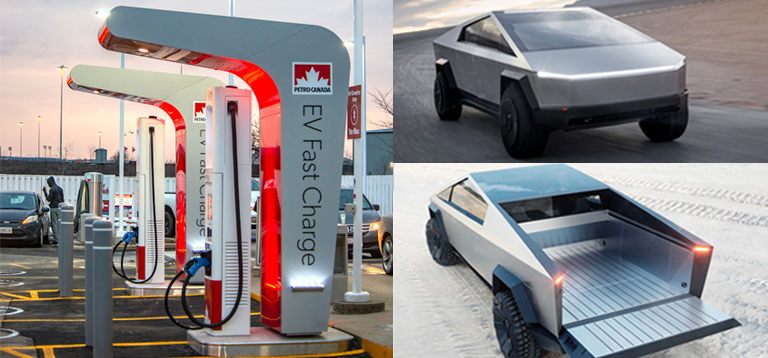Cyber…What?
Tesla’s long-awaited all-electric pickup truck is here—and it’s certainly something.
On Thursday night, Tesla CEO Elon Musk revealed the automaker’s long-promised Cybertruck at the Tesla Design Studio in Hawthorne, Calif. With the launch, Tesla is dipping its toes into one of the most profitable corners of the U.S. auto market, as pickup trucks account for one in every six cars sold in the States.
The stainless steel alloy truck—which has been dubbed a “large metallic trapezoid” by even the biggest of brand fans—will come in three versions, with a 250-mile range (402 kilometres), 300-mile range (484 km) and 500-mile range (564 km).
“I think the Tesla side of our truck is our best product ever,” Musk said before the launch, calling the vehicle “heart-stopping” and deeming it his “personal favourite” in Tesla’s lineup.
According to Musk, the Cybertruck can go from 0 to 60 mph (0 to 96.5 km/h) in just 2.9 seconds, while the top-tier version can travel a quarter of a mile (just under half a kilometre) in 10.8 seconds.
The truck also features Tesla Armor Glass, which Musk coined “metal transparent glass.” A demonstration of glass’ strength was held on stage with a prototype, but when it came time to test the truck’s actual windows, Tesla had a bit of a hiccup.
“Oh my gosh,” Musk said as he watched the Cybertruck’s window shatter. “Maybe that was a little too hard.”
The Cybertruck starts at US$39,900, for the 250-mile range version, while the mid-range Cybertruck adds an additional US$10,000. The 300-mile range, tri-motor variant is said to wrack up a bill of US$69,900.
Autonomy in the Alps
Hamilton, Ont. residents will have to welcome some new, self-reliant hikers in the new year, as streets in the South Mountain neighbourhood will start serving as a testing grounds for autonomous vehicle technology in the second quarter of 2020.
Hamilton was selected as one of six “regional technology demonstration sites” after a city council vote on Nov. 18. Six streets will serve as a public testbed—all chosen by Hamilton’s regional innovation centre, the Innovation Factory’s Centre for Integrated Transportation and Mobility—and will see both regular and autonomous traffic.
Self-driving cars will be tested alongside regular vehicle traffic, but human drivers will always be present in case something goes wrong.
However, the streets won’t actually be used as runways for autonomous vehicles. The technological component for integrating such self-driving technology, along with AI, sensors, vehicle-to-infrastructure communication and noise tracking technology, will undergo testing—not the actual cars themselves, but rather the way they interact with the world around them.
“The different systems will be on a platform, on a track, that is sending data back in real-time to the control centre,” said John-Paul Danko, ward councillor for Hamilton. “At least, that is my interpretation of it. It’s not just an entire car driving itself around.”
Hamilton is not the first city in Ontario delving into autonomous tech—in May, Windsor and London joined the province’s autonomous vehicle program, working on autonomous vehicle cybersecurity and cross-border technology as part of an $80 million commitment over the next five years.
Heralding a Highway
Electric vehicle drivers can now top-up their EVs at Nanaimo, B.C.’s new Petro-Canada station, the first B.C. stop on Canada’s national Electric Highway.
The Petro-Canada chargers started operation in October and are links in a network of 12 high-speed vehicle charging sites planned for British Columbia and eventually spanning across Canada. Petro-Canada—the first hydro-carbon fuel retailer to plug into the electric vehicle energy supply market—is already operating EV charging stations in Alberta, Saskatchewan, Ontario, Quebec, New Brunswick and Nova Scotia.
“Once we’ve completed it, you will be able to drive across Canada from Nova Scotia to British Columbia,” said Nicole Fisher, spokeswoman for Suncor, which owns Petro-Canada. “The charges are placed about 200 to 250 kilometres apart because that’s how long your average car charge will last. So, in order to be able to go across the country and have that road trip experience—that’s why you’ll see stations that might seem a little unusual from a traditional standpoint of where you might put an electric vehicle charger—but we really wanted it to help with that drive across the country.”
More charging stations will be seen throughout B.C., with locations planned for Victoria, the Lower Mainland, across the southern part of the province to Golden. Three stations are currently in the pre-opening stages, while the others are under construction.
“The Nanaimo site just happened to have the biggest lot, which made construction easier and faster,” said Ed Tkachuk, franchise owner.






































2 Responses
Correction on the top tier trimotor Cybertruck, expected range will be 500 miles (800km)
Thank you! It has been updated.